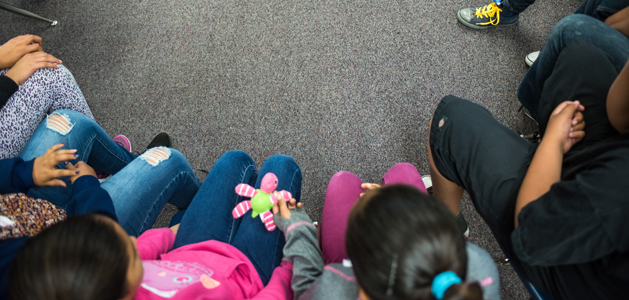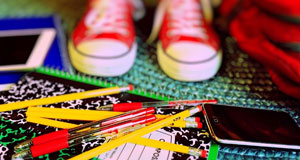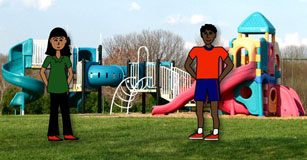5 Ideas to Better Engage with Your Students
Connect deeply, give responsibility, and watch them shine

When I first stepped foot into my own classroom, I held dear to a zero-tolerance, tough as nails approach; operating on a three-strikes-no-matter-what-you’re-out system. But it quickly became obvious how little that approach helped the students in my classroom.
As I reflected on my own pedagogy and methodology, I developed a new teacher lens based more on mutual respect and less on being a control freak. I even became a restorative practitioner. While you may not be ready to make that leap, here are some ways you can get started making powerful connections with the students in your classroom.
1. Have personal conversations with students.
A simple “How are you today?” can turn the entire day around for a kid! When you ask questions, be sure they are open ended. Try this experiment: Ask the first kid who walks into your room or office “Did you have a good weekend?” and then ask the next kid “What did you do this weekend?” It won’t be hard to see the different types of answers you get and which questions naturally solicit more information.
My favorite questions vary, but I always try to zero in on the particular student I am talking to. For example, I might ask:
- How did that meeting turn out?
- What did you end up deciding on ____?
- How did your friends react when you told them about ______?
- What was your favorite part about the ______?
- What are you most looking forward to this week?
But here’s the trick; you cannot ask questions like these and NOT listen to the answer. Which takes us directly to…
2. Start listening more.
Not fake listening… real listening. This means that when you are having conversations with students, your phone is down and set to silent, your laptop is closed, and your instructional work is put away. Look directly at your student as he/she is talking to you so they know they have your full attention.
Steven Covey, author of incredible mentor texts such as The 7 Habits of Highly Effective People, wrote passionately about the need for empathic listening. Empathic listening means you seek to understand. It means you listen with the intent of building trust.
Take a moment to think about the person in your life that you feel the most connected to, the one you have an incredible amount of respect for. How does that person listen to you? Chances are they actually let you speak. Chances are they do things like look at you, give you their undivided attention, let you finish your sentence, and ask questions to gain a deeper understanding of your situation.
If you ask a personal question to your students, but don’t take the time to wait for an answer and really hear it, they will see a false attempt to connect and walk away believing you don’t care.
3. Provide specific opportunities to develop relationships.
Restorative practices involve way more than just circles, but these are an easy way to build compassion and empathy in your classroom. If you think circles are too touchy-feely, remember you don’t have to use them to get emotional!
Discussing academic content is a painless way to get you and your students acclimated to a circle process, which requires two things:
- That you work together with students to establish protocols for sharing as well as guidelines for acceptable behavior during discussion.
- That all participants are given equal time to share. Many teachers simply choose to move around the circle to share while others use a “talking piece’ or similar object that gives the holder the right to speak. A talking piece can also be passed around the circle or the prerogative to choose the next speaker can be given to the current speaker, until all students have shared.
Need to review for a test? Need to introduce a new topic? Use a circle to pose questions that get students connected to their work. For example: “What was hard/easy about last night’s homework?” or “On a scale of 1-10, how clear are you on this topic?”
Not every minute of every day has to be spent on curriculum. What can you do to build community, to foster a sense of trust and belonging? Build a sense of camaraderie and teamwork with a circle game like the Human Knot.
You can also use circles for a quick formative assessment. Go around a circle for a quick check-in at the beginning, middle or end of a class. Use this as an exit ticket, a progress check, or a way to catch a vibe of your class after an incident on campus. Use one simple question, like “How do you feel about _____?”, “Where are you at with _____?” or “On a scale of 1-5, how important is this issue to you and why?”
4. Give restoration a try.
Many people are uncomfortable with restorative justice because the process looks different than the typical punitive approach used in many classrooms. While a punitive approach seems to provide instant results; after all you got to yell at them and they were removed. But in reality, the result is actually temporary. They almost always come back, and they usually bring the same old behavior back with them.
In a restorative process, all affected parties are brought together. If I caused a harm to a classmate and was involved in a face-to-face decision making process with them, there is greater potential for comprehending what I did wrong and what actions I can take to make it right for the student affected. With understanding comes conscious awareness and empathy. Which ultimately means… behaviors have changed!
“With people, fast is slow, and slow is fast.” —Stephen Covey
Restorative justice is slow and requires effort. It requires love and a willingness to do what is best for those affected, like including them in the conversations and decisions. Through the process, the root of the problem is more likely to be uncovered and addressing the root is the only way to truly transform behavior.
5. Get your naysayers on board.
Pull that negative talker aside before class and share something like “I really value your opinion and I would love to hear more from you today.” So they feel important and needed. Compliments also work wonders, and while it might take minute to think of one for an exceptionally challenging student, everybody is good at something. Find the right moment, make it specific, and wait for the smile to appear!
To successfully engage your naysayers, you really have to be practicing the first four ideas well. It would be pointless to ask a naysayer to do something that isn’t interesting to them. In order to know what interests them, you need to build a relationship. In order to build a relationship, you need to ask questions and truly listen to the answers.
Engage the naysayers in a positive way to build trust between you. Then, when you put some leadership responsibilities on their plate, they are ready and willing to rise to the challenge.
You need to customize your approach to each individual. For example, put a really vocal student in charge of a circle or discussion. They are often happy to remind everyone else about the community guidelines and are willing to speak up and pose questions. Part of being in charge is getting everyone else to participate, so they can’t just speak up to answer their own questions.
Shy, or even sulky, students don’t usually want to participate at all. Give them the discussion circle questions or topic ahead of time, so they can think first and formulate answers before having to share. Rather than being sulky, the student may just hate being put on the spot.
So jump in!
To make real connections to your learners, you need to know each student as an individual, not just a body occupying space. Then you’ll know the triggers to avoid and the mechanisms you might be able to use to hook and pull them in. Win their hearts and they’ll always rise up to meet you.














